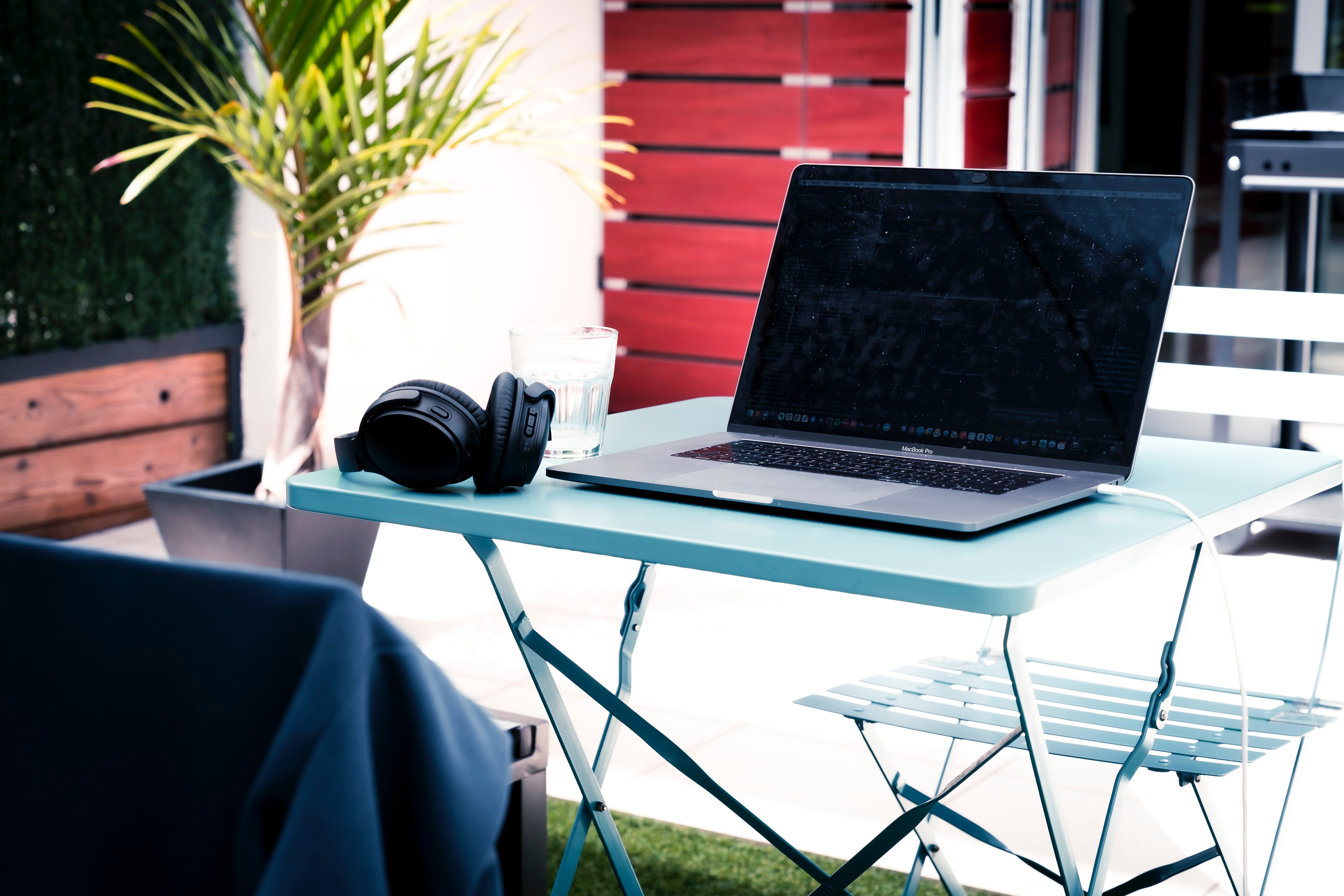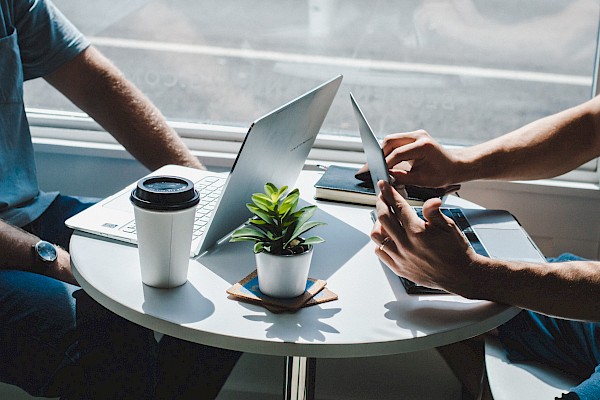The working environment
What job are you qualified for, and what is your current job? Maybe you work in an office job? If you do your job at a desk in the office every day, you probably already know that your working environment can affect you. In this blog post you will learn which aspects of your environment play an important role, and what you can do to optimise working conditions.
Desk, chair, work?
The Covid-19 pandemic has turned everything upside-down, both our private lives and our everyday working lives. Did you work from home too, or are you still WFH temporarily? Your working space at home is likely to be very different from your actual office at your employer’s. How did you set it up? What did you consider when you were setting it up? And did you find that you can concentrate better on your work within your own four walls than in the office – or exactly the opposite? What could be the reason for this?
A desk, a chair and, of course, the work to be done. What more do you need to do your work efficiently and to your own satisfaction? At first glance, you may agree with this. Yet, if you think about it for a bit longer, you will quickly realise that you need more. Most of us can concentrate better when the conditions around us are absolutely quiet. What’s more, the temperature and light conditions can also play an important role. The paragraphs below will tell you how these internal factors affect your health and wellbeing. We have put together a small selection of the most important factors for you.
Acoustics
Acoustics means various different sources of noise. These could be linguistic in nature (e.g., telephone conversations) or non-linguistic (e.g., noises from the printer or from outside). In the office, speech intelligibility is considered more important than volume, because verbal stimuli lead to disturbances, interruptions and distractions on the part of the staff, as they draw people’s attention away from their work. By contrast, volume only rarely rises so high that it causes physical symptoms. Acoustics are the most significant nuisance in offices. Around 20% subjectively evaluate noise as highly stressful. Studies have shown that noise in the workplace can impair both physical and mental wellbeing. A higher noise level affects physical complaints like headaches, but also backache, neck and shoulder pain, loss of appetite, stomach upsets and skin problems. Somewhat more obvious are the findings that noise also negatively affects job satisfaction. Specifically: if an employee feels disturbed by too high a noise level in the office, this negatively affects their health and job satisfaction, which has a knock-on effect on their performance.
What can be done to counteract high noise levels?
As you see, the acoustics cannot simply be ignored. Fortunately, some measures can be taken and implemented to reduce the problem:
- Conversation zones or retreat areas can be made available in open-plan offices. This does not only contribute to avoiding distractions, but also creates a space allowing personal and confidential conversations.
- The rules of the game: rules of behaviour can be set regardless of the office type. How should telephone calls be handled? Should you go into a separate room for them? Where do meetings take place? How and where can spontaneous, possibly long-lasting conversations take place?
- In the best-case scenario, devices such as printers should be kept in separate rooms.
- Sound-proofing materials can be installed on ceilings, walls or floors. They help to absorb noise. In such situations, it is entirely sensible to approach an expert, to ensure that the best material is selected and used.
Light
The sources of light in the office are daylight and artificial lighting (lamps). Of the two, daylight is the more valuable, and should fall into the office space as equally and efficiently as possible. Daylight supports our biorhythms and, in addition, benefits our wellbeing and happiness. Strong contrasts, glares and reflections may disturb employees and result in worsened performance. Studies have shown that lack of access to a window (with a view outside) is the greatest risk factor for satisfaction with the lighting situation. Moreover, an adequate quantity and quality of light also contributes to a better ambience. As lighting preferences can sometimes vary wildly, flexible lighting arrangements are an advantage. Different sources of light (daylight, ceiling lights, desk lamps) combined with options for controlling light (blinds, curtains etc.) allow people to control their lighting conditions.
Temperature
Temperature, including radiative temperature, relative atmospheric humidity and air movement (this last won’t be discussed further here), is part of the internal climate. If people evaluate the climate as poor, the result is reduced happiness. A study has established that employee performance drops by 4 percent when the room temperature is too low, and by 6 percent when it is too high. Just like acoustics and unfavourable lighting conditions, an unpleasant room temperature can result in psychosomatic (physical) complaints, or heighten them where they already exist. When it is too warm, we become sleepy and listless, which both increases the accident rate and also affects our performance and wellbeing.
Air quality
Air quality relates to the purity and freshness of breathable air. This is gauged by how pleasant the people in the room perceive it to be. Here, too, poor quality air results in greater dissatisfaction with the working environment. Another study likewise showed that performance worsens by around 10 percent when the air quality is too low. When too little fresh air comes into the room, the CO2-concentration goes up, which affects our tiredness levels and decision-making. Windows that anyone can open themselves or access to external spaces can remedy this.
When several people work in one office, it can sometimes be hard to adjust these factors individually. Under no circumstances, however, should personal control be underestimated.
The impact of personal control
Control here means the basic human need to be able affect your surroundings and your own internal life as you wish (to control it, or at least predict it). Experiencing control gives us security and is positively correlated with our mental wellbeing. In the professional context, personal control is as significant as the acoustics, temperature, air quality and light. The two internal factors of lighting (light) and acoustics can often be managed by individuals. Conversely, this is not always possible with temperature and air quality, as these are frequently controlled centrally. If the employees have (or at least believe they have) the option of affecting their working environment themselves, their satisfaction, morale and commitment may increase. What’s more, physical symptoms will also decrease if they perceive themselves to be more in control. Ultimately this results in higher productivity and better mental health.
Conclusion
This blog article has shed light on only some of the possible factors. For example, besides those discussed above, there are also colours, scents and plants, which can also have varying effects on our bodies and minds. Our blog post «Green companions» will tell you more about the effects houseplants have on people.
You have learned that both internal factors and how much individual control we have over them plays an important role for our health and wellbeing. Workplaces and their surroundings change from time to time and develop further. This much is clear: the trend is for more open-plan-style offices and the more open (not just in terms of space, but also things like hot-desking) the working environment in the workplace becomes, the less privacy is available to the individual employees. A review study concluded that there is a negative correlation between the level of privacy and emotional exhaustion. This means that the less privacy people have at work, the more emotionally exhausted they become. If it is also difficult to personalise the workspace, these negative effects are reinforced. That’s why it is important for employees to be able to adjust their workspace, even if only temporarily, to match their personal taste.
You can find more information about office spaces and workplaces in this handbook produced by Health Promotion Switzerland. You will see that there are a great many more aspects that are important for optimising work and our health. It also includes a checklist for establishing how good an existing office is.
References
Colenberg, S., Jylhä, T., & Arkesteijn, M. (2021). The relationship between interior office space and employee health and well-being – a literature review. Building Research & Information, 49(3), 352-366. https://doi.org/10.1080/09613218.2019.1710098
Kamarulzaman, N., Saleh, A. A., Hashim, S. Z., Hashim, H., & Abdul-Ghani, A. A. (2011). An overview of the influence of physical office environments towards employee. Procedia Engineering, 20, 262-268. https://doi.org/10.1016/j.proeng.2011.11.164
Kegel, P. (2017). The impact of the physical work environment on organizational outcomes: a structured review of the literature. Journal of Facility Management Education and Research, 1(1), 19-29. https://doi.org/10.22361/jfmer/76637
Konkol, J., Schanné, F., Lange, S., Weichbrodt, J., Degenhardt, B., Schulze, H., Kleibrink, M., Coradi, A., Schweingruber, D., Metzger-Pegau, L., Neck, R., Gisin, L., Wieser, A., & Windlinger, L. (2019). Gesundheitsförderliche Büroräume und Workplace Change Management – ein Leitfaden. Handlungsempfehlungen für Unternehmen in der Schweiz, um bei der Planung, Implementierung und Bewirtschaftung von Büroräumen die psychische Gesundheit der Mitarbeitenden zu fördern (2nd ed.). Gesundheitsförderung Schweiz.
Windlinger, L., Igic, I., & Konkol, J. (2018). Belastende Faktoren im Büroraum und deren Einfluss auf die psychische Gesundheit und das Arbeitsengagement. Ergebnisse aus der Befragung mit Friendly Work Space Job-Stress-Analysis. Faktenblatt 30. Gesundheitsförderung Schweiz.
 subscribe to newsletter
subscribe to newsletter


